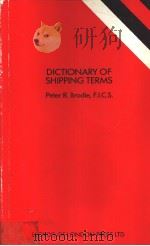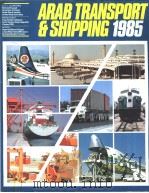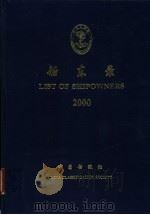《BRITISH SHIPPING LAWS 13 SHIPOWNERS》
| 作者 | 编者 |
|---|---|
| 出版 | STEVENS & SONS |
| 参考页数 | 403 |
| 出版时间 | 1967(求助前请核对) 目录预览 |
| ISBN号 | 无 — 求助条款 |
| PDF编号 | 812906998(仅供预览,未存储实际文件) |
| 求助格式 | 扫描PDF(若分多册发行,每次仅能受理1册) |

1.OWNERSHIP OF TONNAGE1
1. National Tonnage: Overall Concept1
State responsibility1
International case law2
Kinds of ownership3
2. Individual Ownership4
Kinds of registration law4
Rigid laws6
Relaxed laws:flags of “ convenience”7
Balanced laws13
3. Position in English Law14
“British ship”14
Obligation to register19
Government ships20
General scheme21
Republic of Ireland22
Effect of failure to register25
British owners and flags of convenience26
4. Government-Owned Tonnage27
Commercially operated vessels27
English law29
5. International Organisations30
General principles30
International case law31
Intergovernmental organisations39
2. ACQUISITION oF TONNAGE40
1. Methods of Acquisition40
Economics of acquisition40
Kinds of tonnage for acquisition42
How to acquire tonnage44
2. Second-hand ShipsRole of shipbrokers45
3. New Building57
Choice of shipyard57
4. Chartering82
Modern conditions82
Kinds of time charters87
5. Baltic Exchange92
History92
Operations95
World tramp chartering98
2. ACQUISITION OF TONNAGE—continued100
5. Baltic Exchange—ontinued100
Organisation100
Discipline101
Sale and purchase102
3.ENGLISH LAW OF SALE105
1. Contracts for Sale105
Special features105
Formation of contract108
Construction of contracts in writing110
Passing of proper115
(ⅰ)sale or contract115
(ⅱ) second-hand ships121
(ⅲ) shipbuilding138
(ⅳ) specific performance143
Passing of the risk: frustration145
Conditions and warranties: Act of 1893150
Fraud and misrepresentation158
Warranties during negotiations161
Express conditions176
Implied terms: performance of contract185
2. Shipbrokers: Duties and RightsActing for whom?189
Commission192
3. Conflict of Laws197
Proper law of contract197
Jurisdiction of English courts210
4. Forms of Contract for Sale216
Saleform agreement216
Standard yacht-building agreement224
4. OPERATION OF MERCHANT SHIPPING234
1. Kinds of Seaborne Trade234
Classification234
Specialised trades235
Dry cargo trade237
2. Conference System238
Characteristics238
Advantages241
Difficulties242
Organisation243
Practices244
Conference Ratemaking246
Conference and shipper250
Governments and the conference258
Conclusion: future of conference system264
3. Tramp Shipping270
Distinguishing characteristics270
Mechanics of voyage chartering272
4. Bilateralism in Shipping279
Multilateralism279
(1) Bilateral trade280
(2) Bilateral aid284
5. Independent Liner Operators285
4.OPERATION OF MERCANT SHIPPING——continued285
Competing with conferences285
6. Proprietary Owners Individuals and States287
7. Coastal Shipping Cabotage288
5. ORGANISATIONS AIDING SHIPOWNERS292
1. Intergovernmental Organisations Introduction292
Need for international organisations294
General intergovernmental organisations301
IMCO307
2. Non-governmental Organisations Classification311
(A) International Cargo Handling Coordination Association314
(B) International Association of Ports and Harbours317
(C) National organisations in England320
(ⅰ) Liverpool Steam Shipowners’ Association320
(ⅱ) Shipping Advisory Panel321
(ⅲ) National Maritime Board323
(ⅳ) Shipping Federation326
3. Chambers of Shipping327
ICS and ISF327
Chamber of Shipping of the United Kingdom329
Historical survey329
The Chamber’s Royal Charter336
Membership of the Chamber338
Organisation339
International Chamber of Shipping345
Committee of European Shipowners349
Committee of European National Shipowners’Association354
Committee of Liner Operators: South America357
Other international organisations358
Relations with other bodies361
4. Comite Maritime International364
Origin and development364
Object369
Organisation370
Work373
British Maritime Law Association376
The post-war Comite380
5. Classification SocietiesIntroduction383
(i) Lloyd’s Classification Society History385
Essence of classi fication391
Statutory surveys396
Safety Coventions400
(ii) Other Classification Societies403
Full list403
American Bureau of Shipping404
5. ORGANISATIONS AIDING SHIPOWNERS—contirued409
5. Classification Societies—continued409
Bureau Veritas409
Norske Veritas413
Nippon Kaiji Kyokai414
Korean Register of Shipping418
Turk Loydu423
Soviet Classication Society424
Future of classication societies425
6. INSuRANCE IN LONDON428
1. Lloyd’s428
History428
Organisation432
Placing a risk439
Lloyd’s Policy Signing Office440
Settlement of claims441
Average and Recoveries Department442
(ⅰ) General Average, Salvage and Collision Section445
(ⅱ) Shipowners’ Liability Section448
(ⅲ) Non-Marine Recoveries and Refunds Section450
(ⅳ) Marine Payments Section451
Lloyd’s agency system452
Intelligence Department456
Lloyd’s shipping publications457
Lloyd’s Underwriters’ Association462
2. P.and I.Clubs463
(ⅰ) Introduction463
Place in insurance market463
(ⅱ) History465
18th century:limited insurance facilities465
The hull Clubs469
Increase of third party liabilities477
Formation of P.and I.Clubs485
(ⅲ) Scope of Modern Cover490
Collisions,etc490
Death,injury or illness496
Other responsibility for crew,etc500
Responsibility for cargo503
Fines for offences,etc509
“Omnibus” cover510
Limitations on cover512
(ⅳ) The Club and its Members513
Entry513
Legal status515
Calls and deductibles517
Administration and management521
(ⅴ) Related Associations528
Defence associations528
War Risks Associations529
3. Insurance Companies536
Role in London market536
History537
Institute of London Underwriters538
Relations with Lloyd’s: committees540
Relations with Lloyd’s: the market543
Business independent of Lloyd’s547
6.INSuRANCE IN LONDON——continued550
4. Export Credit Guarantees550
Credit insurance by E.C.G.D.550
Facilities provided551
History of E.C.G.D.552
Act of 1949555
Period of credit558
Credit insurance for shipbuilding562
Bank guarantees566
Financial guarantees567
Direct loans by State568
7.PORTS OF THE UNITED KINGDOM570
1. Types of Ports570
(ⅰ)Public trust authorities570
(ⅱ) Municipally-owned ports573
(ⅲ) Nationalised ports574
(ⅳ) Company-owned ports575
Associated authorities576
2. Legislation affecting Ports577
Special enactments577
General enactments578
3. Powers of Port Authorities580
General powers580
Power to make by-laws581
Entry and movement of ships585
4. Port charges590
Ship,passenger and goods dues590
Services and facilities598
Collection of port charges599
Light dues603
5. Rights and Duties of Authorities606
Wreck removal606
Oil in navigable waters609
Limitation of liability610
Damage to dock works611
Pilotage612
6. Organisations Concerned with Ports613
National Ports Council613
Dock and Harbour Authorities’Association615
National Association of Port Employers616
Trinity House617
7. Port of London Authority618
Creation of the P.L.A.618
Constitution622
Jurisdiction623
Functions624
Finance of the P.L.A633
Dues634
8.AGENTS OF CARGO AND SHIP635
1. Forwarding Agents635
Functions635
Institute of Shipping and Forwarding Agents638
Forwarding agent as principal639
8. AGENTS oF CARGO AND SHIP—continued640
1. Forwarding Agents—continued640
Forwarding agent as carrier640
“ Groupage ” bills of lading643
Bailee’s liability in tort644
Personal liability to shipowner647
London custom as to freight648
Other obligations650
Right to sue shipowner in own name651
Forwarding agent’s bill of lading652
Forwarding agent’s lien654
Stoppage in transitu656
2. Loading Brokers657
Function657
Legal Position659
3. Ship’s Agents664
Functions664
4. Bill of Lading Practice668
Introduction668
Arrangements for shipment669
Essential facts detailed671
Format679
Process of issue683
Non-negotiable receipts689
Release of cargo at destination692
Mechanisation693
Life of a bill of lading694
Unit loads694
Sea/air transit695
9.MODEL ALL-PURPOSE BILL oF LADING696
The need696
A model bill of lading706
The carrying clauses712
Preamble or introduction719
Dangerous or politically unsafe goods720
Jurisdiction721
Liner company’s special clauses722
10. SETTLEMENT oF DISPUTES IN LONDON722
1. Commercial Court758
Origin and development758
Order 72 of1964765
Types of action tried in the Commercial Court767
Transfer of an action to the Commercial List770
Summons for directions772
Evidence at the trial776
Order 72778
2. Maritime Arbitration788
Arbitration clauses in charter parties788
Arbitrators as advocates792
Sole arbitrator794
Access to court795
“London Rules”796
London Maritime Arbitrators’Association797
3. Average Adjustment798
History798
Association of Average Adjusters799
Legal position800
11. FIAG DiSCRIMINATION801
1. State Responsibili801
Basic principle801
Sovereign equality of States802
Applications803
Meaning of “flag discrimination”806
2. Effects of the First World War812
New trends812
3. Effects of the Second World War823
Nations newly come to shipping823
Advent of IMCO825
Declarations qualifying entry827
What is “discriminatory”?830
Limitations of IMCO833
Conclusions834
4. Geneva Conventions of 1958 on the Law of the Sea837
Evolutionary effects837
Convention on the Territorial Sea and Contiguous Zone,Geneva1958838
Convention on the High Seas, Geneva 1958839
5. International Convention on the Liability of Operators of Nuclear Ships, Brussels,May 1962 Significance841
6. Practice of States regarding Discrimination U.S.A. v.U.K.trade war842
(A) Practice of United States of America843
(B) State practice of United Kingdom863
(C) State practice of India870
7. Views of International Chambers of Commerce and Shipping on practice of States882
Classes of discrimination882
Examples883
A.Restrictive clauses in trade treaties883
B.Unilateral action by governments885
8.Views of OEEC and other Organisations893
OEEC893
LAFTA894
GATT895
UNCTAD896
ECAFE Shipping Report899
9. International Law Concept of Flag Discrimination Question of legality901
(A) Legal approach903
(B) Position in customary international law919
(C) Approach based on practice of States; concept of an international standard920
1967《BRITISH SHIPPING LAWS 13 SHIPOWNERS》由于是年代较久的资料都绝版了,几乎不可能购买到实物。如果大家为了学习确实需要,可向博主求助其电子版PDF文件(由 1967 STEVENS & SONS 出版的版本) 。对合法合规的求助,我会当即受理并将下载地址发送给你。
高度相关资料
-

- HALSBURY'S LAWS OF ENGLAND VOLUME 13
- 1975 BUTTERWORTHS
-
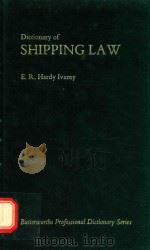
- Dictionary of shipping law
- 1984 Buterworths
-

- Laws of Judges Laws of Evidence
- 1990 Jason Aronson Inc.
-

- THE SHIPPING NEWS
- 1993 SCRIBNER PAPERBACK FICTION
-

- THE natural history of British insectes vol 13-14
- 1810 the author
-
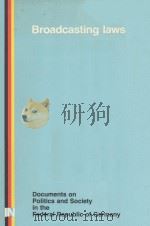
- BROADCASTING LAWS
- 1989 INTER NATIONES
-

- LAWS OF HONG KONG MERCHANT SHIPPING ORDINANCE CAHAPTET 281
- 1982 PRINTED AND PUBLISHED BY THE GOVERNMENT PRINTER
-
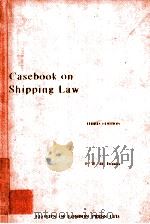
- Casebook on shipping law
- 1982 Lloyd's of London Press
-
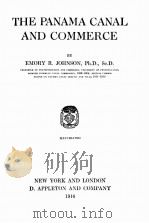
- THE PANAMA CANAL AND COMMERCE
- 1916 D. APPLETON AND COMPANY
-

- AUGUSTINE‘S LAWS
- 1987 PENGUIN BOOKS
-
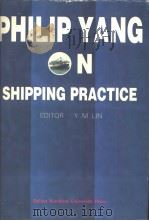
- PHILIP YANG SHIPPING PRACTICE
- 1995 大连海事大学出版社
-

- The World Shipping Industry
- 1987 Croom Helm
提示:百度云已更名为百度网盘(百度盘),天翼云盘、微盘下载地址……暂未提供。➥ PDF文字可复制化或转WORD
